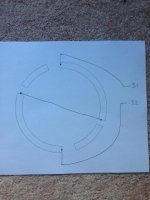The 3HP reliance motor in my wiad 10EE had been refurbed by a motor shop by the previous owner. The shop put in new silicone insulation wire and new bearings. I removed the front end out of curiousity, and the stator coil wires were not what I was expected. I assumed that A1 and A2 would connect to the brushes, F1 and F2 would connect to one coil circuit, and S1 and S2 would connect to another coil circuit. However...
The brushes are in series with the smaller pair of coils, ie, A1 goes to one of the smaller coil terminals then its other terminal goes to the other small coil, then to one brush and the other brush goes to A2. picture 1
The F1 and F2 are connected to the inner connections of the large coils. picture 2
The S1 and S2 are connected to the outer terminals of the large coils. picture 3
Is this right or did the motor shop mess their connections up? The motor seemed to run fine.



The brushes are in series with the smaller pair of coils, ie, A1 goes to one of the smaller coil terminals then its other terminal goes to the other small coil, then to one brush and the other brush goes to A2. picture 1
The F1 and F2 are connected to the inner connections of the large coils. picture 2
The S1 and S2 are connected to the outer terminals of the large coils. picture 3
Is this right or did the motor shop mess their connections up? The motor seemed to run fine.







